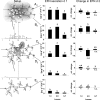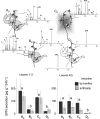Within-plant signaling by volatiles leads to induction and priming of an indirect plant defense in nature
- PMID: 17360371
- PMCID: PMC1838500
- DOI: 10.1073/pnas.0610266104
Within-plant signaling by volatiles leads to induction and priming of an indirect plant defense in nature
Abstract
Plants respond to herbivore attack with the release of volatile organic compounds (VOCs), which can attract predatory arthropods and/or repel herbivores and thus serve as a means of defense against herbivores. Such VOCs might also be perceived by neighboring plants to adjust their defensive phenotype according to the present risk of attack. We exposed lima bean plants at their natural growing site to volatiles of beetle-damaged conspecific shoots. This reduced herbivore damage and increased the growth rate of the exposed plants. To investigate whether VOCs also can serve in signaling processes within the same individual plant we focused on undamaged "receiver" leaves that were either exposed or not exposed to VOCs released by induced "emitter" leaves. Extrafloral nectar secretion by receiver leaves increased when they were exposed to VOCs of induced emitters of neighboring plants or of the same shoot, yet not when VOCs were removed from the system. Extrafloral nectar attracts predatory arthropods and represents an induced defense mechanism. The volatiles also primed extrafloral nectar secretion to show an augmented response to subsequent damage. Herbivore-induced VOCs elicit a defensive response in undamaged plants (or parts of plants) under natural conditions, and they function as external signal for within-plant communication, thus serving also a physiological role in the systemic response of a plant to local damage.
Conflict of interest statement
The authors declare no conflict of interest.
Figures



Comment in
-
Plant volatiles carry both public and private messages.Proc Natl Acad Sci U S A. 2007 Mar 27;104(13):5257-8. doi: 10.1073/pnas.0700906104. Epub 2007 Mar 22. Proc Natl Acad Sci U S A. 2007. PMID: 17379669 Free PMC article. No abstract available.
References
-
- Paré PW, Tumlinson JH. Nature. 1997;385:30–31.
-
- Boland W, Hopke J, Donath J, Nüske J, Bublitz F. Angew Chem Int Ed. 1995;34:1600–1602.
-
- Schmelz EA, Alborn HT, Banchio E, Tumlinson JH. Planta. 2003;216:665–673. - PubMed
-
- Farmer EE, Alméras E, Krishnamurthy V. Curr Opin Plant Biol. 2003;6:372–378. - PubMed
Publication types
MeSH terms
Substances
LinkOut - more resources
Full Text Sources
Other Literature Sources

